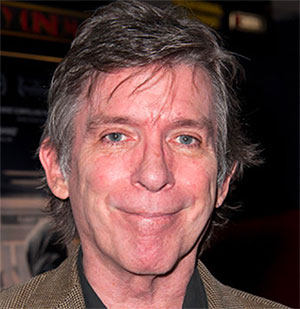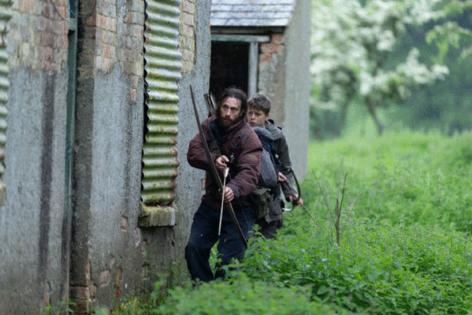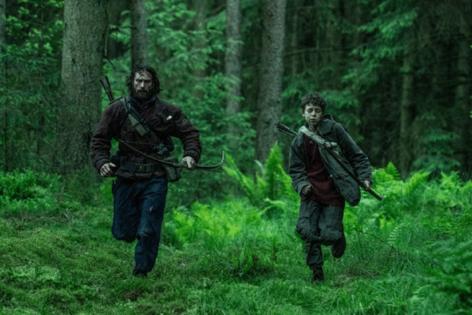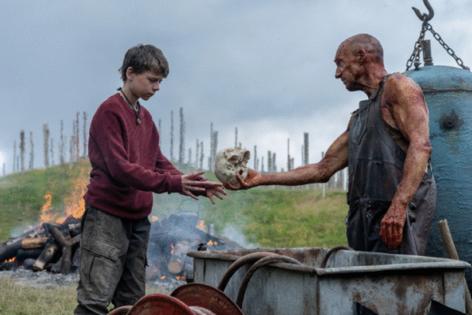Review: '28 Years Later' or Dead Again
The first thing a reviewer should probably do with some movies is to offer only the most general assessment of their twists and secrets. In the case of Danny Boyle's new "28 Years Later" -- a movie of raw, bloodthirsty ambition -- any attempt to describe the picture in useful detail must risk igniting the ire of basement-dwelling spoilerati, who claim an absolute right to have no foreknowledge of any film they haven't seen yet, but who refuse to cease reading early reviews of it.
But something must be said about "28 Years Later," a movie that opens up new areas of exploration in the zombie genre while maintaining the spine-ripping gut-munchery that fans demand. Director Boyle knows his way around laughably low budgets, having started out with scruffy films like "Shallow Grave" and "Trainspotting"; and while his Oscar win for "Slumdog Millionaire" presumably opened up new cash faucets for his work, he still keeps a tight rein on production costs. His new film was shot on an iPhone 15 Pro (heavily accessorized) by his longtime cinematographer Anthony Dod Mantle (who has an Oscar of his own for "Slumdog"). And as was the case with George Romero's pioneering "Night of the Living Dead" back in 1968, the grungy look of this movie enhances its hope-starved horror (which is further intensified by Jon Harris' hallucinatory editing and the music of the terrific Scottish band Young Fathers).
The picture is a sort-of sequel to Boyle's 2002 zombie hit "28 Days Later." (A previous follow-up to that film, the 2007 "28 Weeks Later," wasn't made by Boyle and suffers from that fact.) "28 Years" ignores the last movie, in which the zombie plague spread from Britain to mainland Europe; here, it's been moved back across the Channel, and no time is wasted in putting terrified Brits in peril. It opens with a savage action scene showing a clutch of children gathered around a TV watching "Teletubbies" on the BBC. Suddenly, there's a banging at the door and ... well, zombies come calling in their usual unwelcome way. It's a spectacular open.
The rest of the story (scripted once again by Alex Garland) transports us to the Holy Island of Lindisfarne, off the coast of England, to which it's connected by a narrow stone causeway accessible only at low tide. Here a group of hardy rustics uninfected by the zombie "rage virus" hold on to a semblance of normal life in which they make their own arrows, brew their own beer and generally carry on as best they can. Here we meet a burly character named Jamie (Aaron Taylor-Johnson), his wife Isla (Jodie Comer), and their 12-year-old son Spike (the generously gifted Alfie Williams).
Visits to the zombie-filled mainland aren't encouraged by island leaders, but Jamie is allowed to set out on a journey with Spike on which the boy will make his first zombie kill. This mission involves a wonderfully hideous new creature called a slow-low -- a swollen, sluglike abomination that crawls on the ground sucking up mouthfuls of worms. After some bracingly hair-raising adventures, Jamie and Spike return to the island to tend to Isla, who suffers from an unknown malady.
No doctors are thought to still be living in this world, but it turns out there's one left -- a philosophical recluse named Kelson (Ralph Fiennes), who has dedicated what's left of his life to creating a bone temple built out of the skulls of zombie victims, which he has stacked into high towers (we watch him lovingly plucking bits of flesh from the crevices of these grim artifacts). Kelson is a man who cleaves to the concept of memento mori, believing that humans must always keep in mind that they will die one day, but that they must also remember to love.
At this point, the movie begins plumbing emotional depths not often encountered in horror films, and Boyle gives them plenty of room to resound. This brings Isla to the center of the story (Comer's ability to build a fully rounded woman out of a character overwhelmed by pain and confusion is remarkable) and into the middle of what might be the movie's most spectacular scene, a wild confrontation on an abandoned train. However romantic and contemplative the movie becomes, Boyle makes sure another tasty, pulsing jugular is never far away.
========
To find out more about Kurt Loder and read features by other Creators writers and cartoonists, visit the Creators website at www.creators.com.
Copyright 2025 Creators Syndicate, Inc.


















Comments